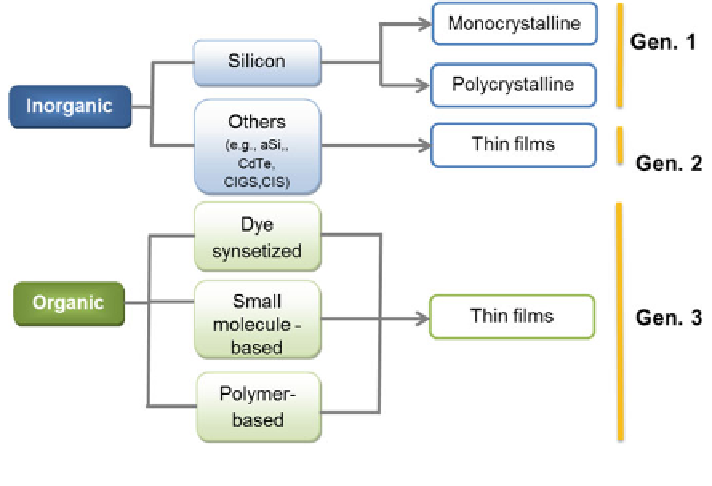Environmental Engineering Reference
In-Depth Information
Fig. 1
A broad classification of photovoltaic technologies
cells is the most known and the oldest photovoltaic technology; there are, however,
a plethora of non-silicon-based solar cells in the market or under development
today. Solar cells can be generally divided into two broad categories depending on
the type of the photoactive material: inorganic and organic solar cells (Fig.
1
).
Among the inorganic solar cells are the first generation solar cells based on silicon
and the second generation solar cells based on thin films of amorphous silicon
(a-Si) and on chalcogenides such as CdSe, CIGS, CdTe, etc. Organic solar cells
form the third generation of photovoltaic technology. Organic solar cells can be
further demarcated into three subdivisions: dye sensitized, small molecules, and
polymer solar cells. Polymer solar cells (PSCs) are the most recent technology and
this chapter is focused on PSCs.
The environmental impact of a photovoltaic technology (or any other green
technology) can be assessed using an indicator derived from life cycle analyses,
namely, energy payback time (EPBT). EPBT is the time it takes for a solar cell to
generate the same amount of energy as expended in its manufacture, use, and final
decommission. The lower the EPBT, the faster is the contribution to clean energy
production. EPBT has been thoroughly investigated for all PV technologies and is
compiled in Fig.
2
from the selected literature to present a comparison of some
photovoltaic technologies [
1
,
2
].
EPBT can simultaneously serve as an indicator for economic profitability of
solar cells. The lowering of EPBT of solar cells requires either a drastic reduction
in materials and manufacturing costs or a dramatic increase in the efficiency of the
solar cells, or a combination thereof. Such measures ultimately reduce the cost of
the electrical energy produced by the solar cells, hence, making the technology

Search WWH ::

Custom Search